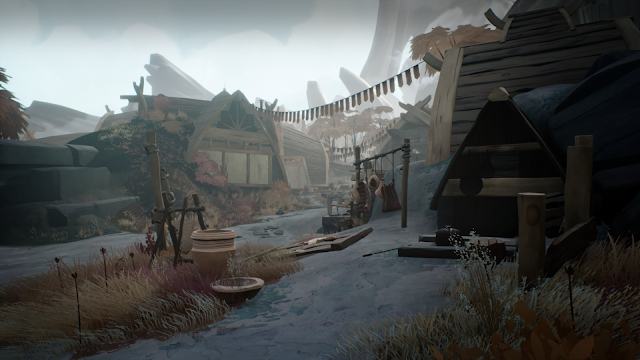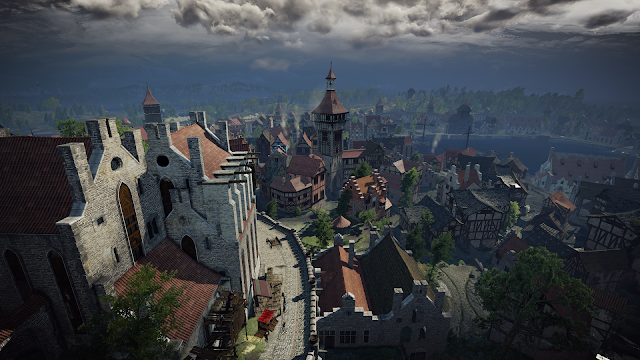Reoccupying Ruins
Walk around Ashen’s game world for long enough and you’ll notice that it’s filled with ancient ruins. Products of its precursor civilizations, the decaying remains of what seem to be settlements are found in each and every one of the game’s different environments. The first which you’ll get to explore is called Vagrant’s Rest.
Home to a band of brigands and robbers, Vagrant’s Rest at first is really just a random collection of rubble and rocks, but slowly transforms into a vibrant settlement as you progress in the game. The piles of debris gradually disappear. Collapsed columns are put back in place. People start to fill the streets. You come across Vagrant’s Rest in a rather sorry state, but the settlement seems pretty prosperous by the time you make it to the game’s final chapter.
In its depiction of settlements like Vagrant’s Rest, Ashen raises the question of how and why ruins are reoccupied. Carting away their remains, we typically demolish abandoned buildings today, but this wasn’t a particularly common practice in the past. As a professional field archaeologist, I’ve noticed that ruins have been reoccupied in basically two different ways throughout human history. While they’ve typically been taken apart and recycled, people have sometimes preferred to build into and around them, too. You can see both of these practices at work in Ashen. Rome provides an interesting real-world parallel.
Vagrant’s Rest becomes a burgeoning settlement shortly after you clear out the aforementioned band of brigands and robbers. Buildings begin popping up all over the place. You won’t find anyone demolishing the ancient ruins, though. While they’re definitely dismantled by their latest occupants, the most useful parts of them are apparently recycled. You can see this quite clearly when it comes to their characteristic stone slabs. These can frequently be found in the quoins, columns, and corbels of the buildings which you’ll come across under construction. Walk around Vagrant’s Rest at almost any point in the game and you’ll see how these materials are slowly integrated into the new structures. They’re a bit like a skeleton.
Rome was the world’s largest city in the second century, but its population dwindled over the next few hundred years. Buildings were progressively abandoned. While its wooden insulae fell prey to the constant fires, most of its marble monuments quite simply fell into ruin. When the population once again started to expand in the tenth century, some of these monuments were preserved as churches, but the vast majority of them were mercilessly looted for their building materials. Pompey’s Theater provides a case in point. While its marble was recycled for the production of lime, the structure’s travertine decorates a Renaissance mansion called the Palazzo della Cancelleria today. The building’s concrete skeleton furnishes a foundation to the nearby Palazzo Orsini Pio Righetti.
Venture beyond Vagrant’s Rest and you’ll come across a completely different kind of reoccupation. The area near Einarden Reach in particular shows that ruins aren’t always recycled. There’s a collapsed castle between Listener’s Ridge and Prophet’s Rise, but the building’s latest occupants clearly aren’t interested in pursuing the same sort of redevelopment which you can see underway in Vagrant’s Rest. Setting up wooden scaffolding to support the crumbling castle, they apparently prefer to build into and around these ancient ruins. They don’t seem to be dismantling the structure. There’s no evidence of recycling. Pitching camp in its cavernous halls, these people appear to have simply moved right in.
Pompey’s Theater was looted for its building materials in the tenth century, but the Colosseum was spared a similar fate. The ruins of these two buildings were reoccupied in completely different ways. While people took apart and recycled Pompey’s Theater, they converted the Colosseum into a variety of houses, shops, and factories. Fortified by the Frangipani family, the structure at one point even became a castle. Some of its marble and travertine was shaken loose by an earthquake in the fourteenth century, but the building has remained remarkably intact over the years. Thousands of sightseers walk through the structure every day.
Why are some ruins taken apart and recycled while others are built into and around? The answer mostly concerns their state of preservation.
While the Colosseum stood the test of time, Pompey’s Theater seems to have already been in shambles by the tenth century. Since it could collapse at any moment, the structure was looted for its building materials instead of being converted into houses, shops, and factories like the Colosseum. The same could seemingly be said about Vagrant’s Rest. While anything prior to the present state of the game world is purely a part of Ashen’s lore, the clues which you’ll come across in the settlement certainly hint in this direction. There are clear signs of recycling. The collapsed castle near Einarden Reach is another story, though. Similar to the Colosseum, the latest occupants of these ancient ruins apparently just moved right in. The reason for this different approach was presumably their solid state of preservation.
Home to a band of brigands and robbers, Vagrant’s Rest at first is really just a random collection of rubble and rocks, but slowly transforms into a vibrant settlement as you progress in the game. The piles of debris gradually disappear. Collapsed columns are put back in place. People start to fill the streets. You come across Vagrant’s Rest in a rather sorry state, but the settlement seems pretty prosperous by the time you make it to the game’s final chapter.
In its depiction of settlements like Vagrant’s Rest, Ashen raises the question of how and why ruins are reoccupied. Carting away their remains, we typically demolish abandoned buildings today, but this wasn’t a particularly common practice in the past. As a professional field archaeologist, I’ve noticed that ruins have been reoccupied in basically two different ways throughout human history. While they’ve typically been taken apart and recycled, people have sometimes preferred to build into and around them, too. You can see both of these practices at work in Ashen. Rome provides an interesting real-world parallel.
 |
| Ashen is filled with ancient ruins |
Vagrant’s Rest becomes a burgeoning settlement shortly after you clear out the aforementioned band of brigands and robbers. Buildings begin popping up all over the place. You won’t find anyone demolishing the ancient ruins, though. While they’re definitely dismantled by their latest occupants, the most useful parts of them are apparently recycled. You can see this quite clearly when it comes to their characteristic stone slabs. These can frequently be found in the quoins, columns, and corbels of the buildings which you’ll come across under construction. Walk around Vagrant’s Rest at almost any point in the game and you’ll see how these materials are slowly integrated into the new structures. They’re a bit like a skeleton.
 |
| Vagrant's Rest at first is nothing but rubble |
Rome was the world’s largest city in the second century, but its population dwindled over the next few hundred years. Buildings were progressively abandoned. While its wooden insulae fell prey to the constant fires, most of its marble monuments quite simply fell into ruin. When the population once again started to expand in the tenth century, some of these monuments were preserved as churches, but the vast majority of them were mercilessly looted for their building materials. Pompey’s Theater provides a case in point. While its marble was recycled for the production of lime, the structure’s travertine decorates a Renaissance mansion called the Palazzo della Cancelleria today. The building’s concrete skeleton furnishes a foundation to the nearby Palazzo Orsini Pio Righetti.
 |
| Vagrant's Rest becomes a stately settlement over time |
Venture beyond Vagrant’s Rest and you’ll come across a completely different kind of reoccupation. The area near Einarden Reach in particular shows that ruins aren’t always recycled. There’s a collapsed castle between Listener’s Ridge and Prophet’s Rise, but the building’s latest occupants clearly aren’t interested in pursuing the same sort of redevelopment which you can see underway in Vagrant’s Rest. Setting up wooden scaffolding to support the crumbling castle, they apparently prefer to build into and around these ancient ruins. They don’t seem to be dismantling the structure. There’s no evidence of recycling. Pitching camp in its cavernous halls, these people appear to have simply moved right in.
 |
| The castle near Einarden Reach was built into by its latest occupants |
Pompey’s Theater was looted for its building materials in the tenth century, but the Colosseum was spared a similar fate. The ruins of these two buildings were reoccupied in completely different ways. While people took apart and recycled Pompey’s Theater, they converted the Colosseum into a variety of houses, shops, and factories. Fortified by the Frangipani family, the structure at one point even became a castle. Some of its marble and travertine was shaken loose by an earthquake in the fourteenth century, but the building has remained remarkably intact over the years. Thousands of sightseers walk through the structure every day.
Why are some ruins taken apart and recycled while others are built into and around? The answer mostly concerns their state of preservation.
While the Colosseum stood the test of time, Pompey’s Theater seems to have already been in shambles by the tenth century. Since it could collapse at any moment, the structure was looted for its building materials instead of being converted into houses, shops, and factories like the Colosseum. The same could seemingly be said about Vagrant’s Rest. While anything prior to the present state of the game world is purely a part of Ashen’s lore, the clues which you’ll come across in the settlement certainly hint in this direction. There are clear signs of recycling. The collapsed castle near Einarden Reach is another story, though. Similar to the Colosseum, the latest occupants of these ancient ruins apparently just moved right in. The reason for this different approach was presumably their solid state of preservation.



